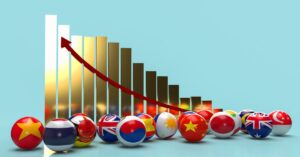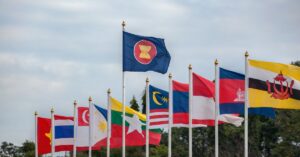The COVID-19 pandemic has presented unprecedented challenges to the global economy, with ASEAN countries being no exception. Trade performance across the region has been significantly affected, yet the crisis also unveils new opportunities for economic recovery and regional cooperation. This article explores the multifaceted impacts of the pandemic on ASEAN’s trade performance and discusses the potential prospects for a post-pandemic future.
Emerging from the initial shockwaves of the pandemic, ASEAN countries faced a drastic decline in trade activities (Aldaba, 2020). As global demand plummeted, exports from ASEAN countries contracted sharply. Supply chain disruptions, coupled with containment measures, further compounded the adverse effects on production and trade (IMF, 2020). Additionally, the pandemic accelerated the ongoing reconfiguration of global value chains, prompting businesses to reassess their reliance on single-source suppliers and encouraging a shift towards more regionalized and diversified supply chains (Baldwin & Evenett, 2020).
Despite these challenges, the COVID-19 pandemic has also unveiled new opportunities for ASEAN countries. The rapid digital transformation driven by the crisis has spurred growth in e-commerce, telecommunication services, and other digital sectors (UNCTAD, 2020). The expansion of digital trade can potentially contribute to the region’s economic recovery and pave the way for more inclusive, sustainable, and resilient growth (Koh & Rastogi, 2020).
Moreover, the pandemic has underscored the importance of regional cooperation and integration among ASEAN countries. The establishment of the ASEAN Comprehensive Recovery Framework (ACRF) in November 2020 demonstrates the region’s commitment to a collective response to the crisis, aiming to restore growth, maintain social stability, and strengthen regional value chains (ASEAN, 2020). Furthermore, the signing of the Regional Comprehensive Economic Partnership (RCEP) in the midst of the pandemic signals the region’s determination to promote free trade and enhance economic integration (Petri & Plummer, 2020).
Looking ahead, ASEAN countries must continue to prioritize their efforts to mitigate the pandemic’s impact on trade performance. This includes adopting a coordinated approach to reopen borders, facilitate trade, and streamline customs procedures (ASEAN, 2020). In addition, fostering digital trade and addressing the digital divide should be at the forefront of the region’s agenda, along with strengthening regional value chains and enhancing supply chain resilience (Koh & Rastogi, 2020).
In conclusion, the COVID-19 pandemic has had profound implications for ASEAN’s trade performance, presenting both challenges and opportunities. By harnessing the potential of digital trade and fostering regional cooperation, ASEAN countries can navigate the crisis and pave the way for a more resilient, sustainable, and inclusive future.
References:
Aldaba, R. M. (2020). ASEAN’s Trade Performance Amid the COVID-19 Pandemic. Philippine Journal of Development, 47(2), 1-20.
ASEAN (2020). ASEAN Comprehensive Recovery Framework
Baldwin, R., & Evenett, S. J. (2020). COVID-19 and Trade Policy: Why Turning Inward Won’t Work. CEPR Press.
IMF (2020). Regional Economic Outlook: Asia and Pacific, Navigating the Pandemic: A Multispeed Recovery in Asia.
Koh, T., & Rastogi, A. (2020). Digital Trade in the Post-COVID-19 World: Prospects and Challenges for ASEAN. Asia-Pacific Review, 27(2), 195-211.











